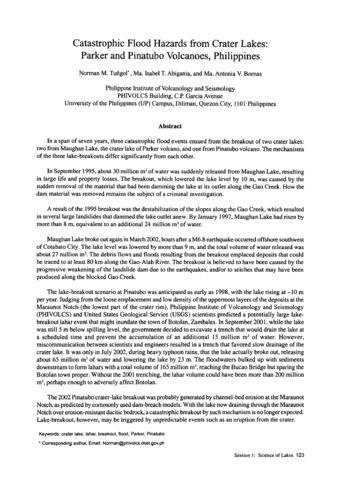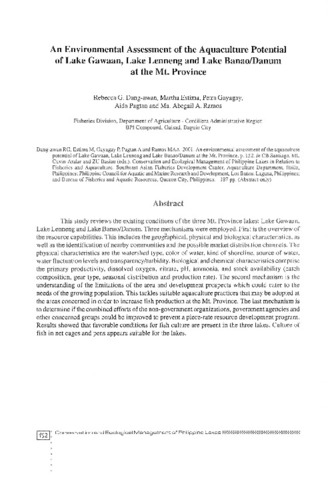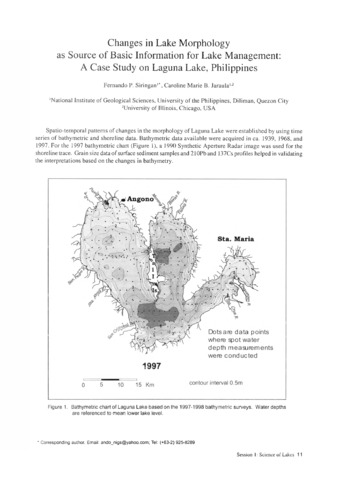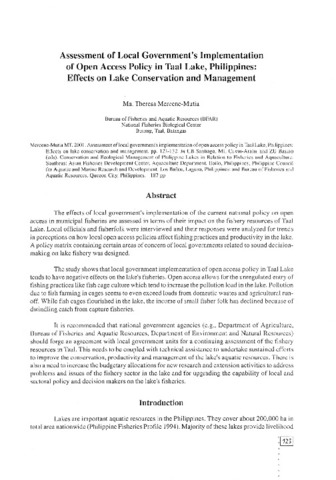Catastrophic flood hazards from crater lakes: Parker and Pinatubo volcanoes, Philippines
| dc.contributor.author | Tuñgol, Norman M. | |
| dc.contributor.author | Abigania, Ma. Isabel T. | |
| dc.contributor.author | Bornas, Ma. Antonia V. | |
| dc.contributor.editor | Cuvin-Aralar, Maria Lourdes | |
| dc.contributor.editor | Punongbayan, Raymundo S. | |
| dc.contributor.editor | Santos-Borja, Adelina | |
| dc.contributor.editor | Castillo, Lourdes V. | |
| dc.contributor.editor | Manalili, Eduardo V. | |
| dc.contributor.editor | Mendoza, Marlynn M. | |
| dc.coverage.spatial | Pinatubo, Mount | en |
| dc.date.accessioned | 2021-07-27T05:43:23Z | |
| dc.date.available | 2021-07-27T05:43:23Z | |
| dc.date.issued | 2005 | |
| dc.identifier.citation | Tuñgol, N. M., Abigania, Ma. I. T., & Bornas, Ma. A. V. (2005). Catastrophic flood hazards from crater lakes: Parker and Pinatubo volcanoes, Philippines. In M. L. Cuvin-Aralar, R. S. Punongbayan, A. Santos-Borja, L. V. Castillo, E. V. Manalili, & M. M. Mendoza (Eds.), Proceedings of the First National Congress on Philippine Lakes (p. 123). Southeast Asian Regional Center for Graduate Study and Research in Agriculture (SEARCA). | en |
| dc.identifier.issn | 1656-8099 | |
| dc.identifier.uri | http://hdl.handle.net/10862/6126 | |
| dc.description | Abstract only. | en |
| dc.description.abstract | In a span of seven years, three catastrophic flood events ensued from the breakout of two crater lakes: two from Maughan Lake, the crater lake of Parker volcano, and one from Pinatubo volcano. The mechanisms of the three lake-breakouts differ significantly from each other. In September 1995, about 30 million m3 of water was suddenly released from Maughan Lake, resulting in large life and property losses. The breakout, which lowered the lake level by 10 m, was caused by the sudden removal of the material that had been damming the lake at its outlet along the Gao Creek. How the dam material was removed remains the subject of a criminal investigation. A result of the 1995 breakout was the destabilization of the slopes along the Gao Creek, which resulted in several large landslides that dammed the lake outlet anew. By January 1997, Maughan Lake had risen by more than 8 m, equivalent to an additional 24 million m3 of water. Maughan Lake broke out again in March 2002, hours after a M6.8 earthquake occurred offshore southwest of Cotabato City. The lake level was lowered by more than 9 m, and the total volume of water released was about 27 million m3. The debris flows and floods resulting from the breakout emplaced deposits that could be traced to at least 80 km along the Gao-Alah River. The breakout is believed to have been caused by the progressive weakening of the landslide dam due to the earthquakes, and/or to seiches that may have been produced along the blocked Gao Creek. The lake-breakout scenario at Pinatubo was anticipated as early as 1998, with the lake rising at ~10 m per year. Judging from the loose emplacement and low density of the uppermost layers of the deposits at the Maraunot Notch (the lowest part of the crater rim), Philippine Institute of Volcanology and Seismology (PHIVOLCS) and United States Geological Service (USGS) scientists predicted a potentially large lake-breakout lahar event that might inundate the town of Botolan, Zambales. In September 2001, while the lake was still 5 m below spilling level, the government decided to excavate a trench that would drain the lake at a scheduled time and prevent the accumulation of an additional 15 million m3 of water. However, miscommunication between scientists and engineers resulted in a trench that favored slow drainage of the crater lake. It was only in July 2002, during heavy typhoon rains, that the lake actually broke out, releasing about 65 million m3 of water and lowering the lake by 23 m. The floodwaters bulked up with sediments downstream to form lahars with a total volume of 165 million m3, reaching the Bucao Bridge but sparing the Botolan town proper. Without the 2001 trenching, the lahar volume could have been more than 200 million m3, perhaps enough to adversely affect Botolan. The 2002 Pinatubo crater-lake breakout was probably generated by channel-bed erosion at the Maraunot Notch, as predicted by commonly used dam-breach models. With the lake now draining through the Maraunot Notch over erosion-resistant dacitic bedrock, a catastrophic breakout by such mechanism is no longer expected. Lake-breakout, however, may be triggered by unpredictable events such as an eruption from the crater. | en |
| dc.language.iso | en | en |
| dc.publisher | Southeast Asian Regional Center for Graduate Study and Research in Agriculture (SEARCA) | en |
| dc.subject | Crater lake | en |
| dc.subject | Lahar | en |
| dc.subject | Breakout | en |
| dc.subject | Philippines | en |
| dc.title | Catastrophic flood hazards from crater lakes: Parker and Pinatubo volcanoes, Philippines | en |
| dc.type | Conference paper | en |
| dc.citation.spage | 123 | en |
| dc.citation.conferenceTitle | Proceedings of the First National Congress on Philippine Lakes | en |
| dc.subject.asfa | flooding | en |
| dc.subject.asfa | volcanoes | en |
| dc.subject.asfa | hazards | en |
| dc.subject.asfa | lakes | en |
Files in this item
รายการนี้ปรากฏใน (s)
-
LakeCon2003 [49]
Proceedings of the First National Congress on Philippine Lakes





